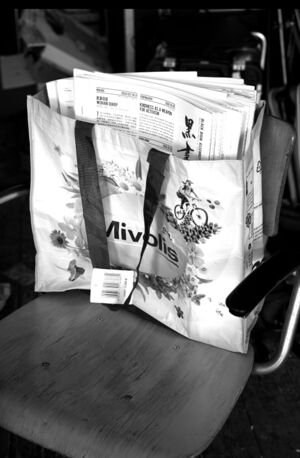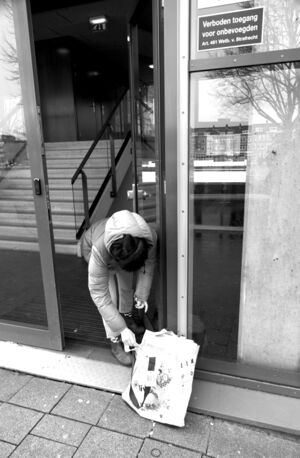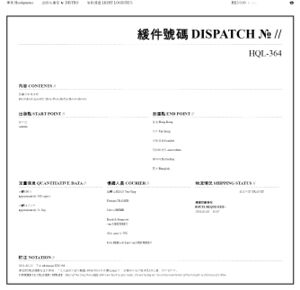Collective organization: Difference between revisions
No edit summary |
|||
| (33 intermediate revisions by 3 users not shown) | |||
| Line 1: | Line 1: | ||
==collective | ==collective organization== | ||
===logistics part II=== | |||
<span class="author">Elaine W. Ho & Florian Cramer</span> | |||
<div class="no-indent">The following edited correspondence ran in parallel to shipment HQL-364 from Rotterdam to Hong Kong through the network of LIGHT LOGISTICS, and was preceded by the correspondence in <mark class="c6">distribution</mark></div><br> | |||
'''EWH:''' I think the need to play with formats of work, organization, and <mark class="c6">distribution</mark> are now more urgent than ever before—not because crisis is upon us, but because the problems that were always there have been revealed more blatantly. Why art, design, and culture are still important is because they deal with methodologies—comings together and ways of seeing and playing that precede the politics that most everyday folk don’t even realize addresses (or neglects, or unfairly treats) them. So education, and welfare, and government funding all need to go through a self-reflexive hall of mirrors, so to speak. | |||
'''FC:''' I couldn’t agree more. At the same time, I’m afraid of the empty <mark class="c1">gestures</mark> and buzzwords that will get ticked off (like, for example, ‘care’ as a now-ubiquitous noun in art project funding application prose) if this becomes more mainstream. In Europe, I also witness the constant failure of artists to truly commit to collective projects and not just use them as <mark class="c2">platforms</mark> for displaying/performing their individual portfolios. | |||
'''EWH:''' Yes, it is not surprising at all that we’ve watched the hype on care build up over the last year, but as someone primarily confined to margins, the mainstreaming of discourses is also something to learn and navigate as part of our practices. The tricky thing about care, and so many other widely debated issues is that they really need to be enacted rather than simply theorized or talked about. But the need to repeat, repeat, and repeat again to people who are less affected by what is lacking in the socioeconomic system (power is a crux issue at every scale) is a necessary part of expanding possibility. It entails ‘mainstreaming’ and popularizing and this gives those of us who do want to speak and practice from a position without power a tremendous pressure to <br>re-circuit, re-articulate, and re-work the existing imaginaries. | |||
What you mentioned about the failure to really collectivize in Europe is also a problem in Hong Kong and China. When HomeShop, the artist-run project space I was involved with from 2008–2013, was invited to participate in the ‘Unlived by What is Seen’ exhibition in 2014, the curators told us they wanted to include us as a collective practice because they felt that all the other collectives they observed in China at the time were merely solidarity-for-opportunity kinds of conglomerations, often splitting up when the group becomes famous enough that the individuals of a group can then make their way with solo careers. | What you mentioned about the failure to really collectivize in Europe is also a problem in Hong Kong and China. When HomeShop, the artist-run project space I was involved with from 2008–2013, was invited to participate in the ‘Unlived by What is Seen’ exhibition in 2014, the curators told us they wanted to include us as a collective practice because they felt that all the other collectives they observed in China at the time were merely solidarity-for-opportunity kinds of conglomerations, often splitting up when the group becomes famous enough that the individuals of a group can then make their way with solo careers. | ||
| Line 86: | Line 17: | ||
That said, having much more time to read and dilly-dally around in a confined space these days, I finally got to read your paper on 1970s Mail Art more carefully, and the key value I can take from the various examples you present is to see similar struggles and resonances resulting in similar impulses and tactics, such that your idea of the ‘eternal network’ represents a notion of affinity. | That said, having much more time to read and dilly-dally around in a confined space these days, I finally got to read your paper on 1970s Mail Art more carefully, and the key value I can take from the various examples you present is to see similar struggles and resonances resulting in similar impulses and tactics, such that your idea of the ‘eternal network’ represents a notion of affinity. | ||
'''FC:''' Yes, and I am also wondering whether these struggles, resonances, and mistakes need to be constantly re-enacted and repeated by each new | |||
<span class="page-break"> </span> | |||
[[File:DSCF3051.jpg|thumb|LIGHT LOGISTICS shipment HQL-364, | |||
<br>photo: Florian Cramer.]] | |||
<span class="page-break"> </span> | |||
<div class="no-indent">generation in order to be fully (''i.e,'' not just in an abstract or disembodied manner) understood.</div> | |||
'''EWH:''' There are changes along the way, from generation-to-generation mutation. But I fear that despite such continuities, there is also a repetitive relegation to the realm of marginal play. Whatever foresight those projects from the sixties forward had for internet behaviours today—and as you say our pinpointing of AI/algorithms as the evils of the system is misplaced—how could intimate and networked actions parasitizing off of larger infrastructures really affect anything? | |||
'''FC:''' Maybe that’s the problem—that, by focusing on (larger societal) effects, we’re unintentionally superimposing growth or impact expectations on these projects while their main value might have been their subjective-collective experience, and functioning as an experiment? | |||
'''EWH:''' Thank you for the reminder. I have to tell myself again and again in so many arenas to focus upon ‘subjective-collective experience, and functioning as an experiment’, rather than the unintentional but hard-to-escape notions of growth, development, and impact, as you say… The question of change is perhaps naïve and misplaced. Regardless, it is difficult not to acknowledge outcomes as part of the process of communication that happens among any form of ''collective organizing''. How that communication occurs is central to the difference between centralized or decentralized processes, and I think Display Distribute’s inquiry into grey economies actually implicates us within certain murky areas between centralization and decentralization. These have been some of the greatest challenges to the project, but they are reasons to continue. You are right that ‘radical inclusivity’ does not necessarily garner any momentum, but neither do elitism and the reverse snobbery of oligarchic movements, which is a critique of both ends of the political spectrum. | |||
If as you say the main value is located in the experiment of a subjective-collective experience, then your previous question might be answered by saying that the constant re-enactments and repetitions by new generations ''are'' necessary. Embodiment and affect cannot be historically reviewed except as practiced singularities, right? | If as you say the main value is located in the experiment of a subjective-collective experience, then your previous question might be answered by saying that the constant re-enactments and repetitions by new generations ''are'' necessary. Embodiment and affect cannot be historically reviewed except as practiced singularities, right? | ||
'''FC:''' Yes, but you could also criticize that as a petty-bourgeois hobbyist self-limitation that gives up on the larger picture… | |||
'''EWH:''' Completely on the mark as well! There is a close friend with whom I have had many emotional disputes along these lines, and perhaps this pinpointed critique precisely circles us back in some way—whether as a picture or a way of manoeuvring—to the necessities of an eternal network. | |||
2021-02-19 | <br> | ||
'''2021-02-19''' | |||
<br> | |||
Dear 慢遞員易拎何子 (& 妍廷), | Dear 慢遞員易拎何子 (& 妍廷), | ||
HQL-364 is currently quarantined in a hotel in Taichung. Elaine, I hope it’s not a major let-down that we have only been able to bag | HQL-364 is currently quarantined in a hotel in Taichung. Elaine, I hope it’s not a major let-down that we have only been able to bag thirteen copies because of the bulkiness of Yenting’s luggage. My agreement with courier Amy S. Wu was that she would give me a large stack of copies and that I would return to her whatever wouldn’t fit the luggage. The remaining 62 copies are currently at my home and still need to be returned to Amy, who lives nearby. | ||
<br> | |||
Florian | Florian | ||
[[File:DSCF3147.jpg|thumb|delivery of LIGHT LOGISTICS shipment HQL-364, | |||
<br>photo: Florian Cramer.]] | |||
]] | <span class="spread">[[File:Screendd1spreadline.jpg|thumb]]</span> | ||
Latest revision as of 08:21, 19 April 2022
collective organization
logistics part II
EWH: I think the need to play with formats of work, organization, and distribution are now more urgent than ever before—not because crisis is upon us, but because the problems that were always there have been revealed more blatantly. Why art, design, and culture are still important is because they deal with methodologies—comings together and ways of seeing and playing that precede the politics that most everyday folk don’t even realize addresses (or neglects, or unfairly treats) them. So education, and welfare, and government funding all need to go through a self-reflexive hall of mirrors, so to speak.
FC: I couldn’t agree more. At the same time, I’m afraid of the empty gestures and buzzwords that will get ticked off (like, for example, ‘care’ as a now-ubiquitous noun in art project funding application prose) if this becomes more mainstream. In Europe, I also witness the constant failure of artists to truly commit to collective projects and not just use them as platforms for displaying/performing their individual portfolios.
EWH: Yes, it is not surprising at all that we’ve watched the hype on care build up over the last year, but as someone primarily confined to margins, the mainstreaming of discourses is also something to learn and navigate as part of our practices. The tricky thing about care, and so many other widely debated issues is that they really need to be enacted rather than simply theorized or talked about. But the need to repeat, repeat, and repeat again to people who are less affected by what is lacking in the socioeconomic system (power is a crux issue at every scale) is a necessary part of expanding possibility. It entails ‘mainstreaming’ and popularizing and this gives those of us who do want to speak and practice from a position without power a tremendous pressure to
re-circuit, re-articulate, and re-work the existing imaginaries.
What you mentioned about the failure to really collectivize in Europe is also a problem in Hong Kong and China. When HomeShop, the artist-run project space I was involved with from 2008–2013, was invited to participate in the ‘Unlived by What is Seen’ exhibition in 2014, the curators told us they wanted to include us as a collective practice because they felt that all the other collectives they observed in China at the time were merely solidarity-for-opportunity kinds of conglomerations, often splitting up when the group becomes famous enough that the individuals of a group can then make their way with solo careers.
So it’s no wonder that so many of us have that starry-eyed fascination with the hype of many Indonesian collectives, haha, but as discussed with my friend Riar Rizaldi in a talk a couple of weeks ago, there are many problems there as well that tend not to get discussed publicly, and the exportation of nongkrong can in some ways be just as much of a selling strategy like anything else.
That said, having much more time to read and dilly-dally around in a confined space these days, I finally got to read your paper on 1970s Mail Art more carefully, and the key value I can take from the various examples you present is to see similar struggles and resonances resulting in similar impulses and tactics, such that your idea of the ‘eternal network’ represents a notion of affinity.
FC: Yes, and I am also wondering whether these struggles, resonances, and mistakes need to be constantly re-enacted and repeated by each new
EWH: There are changes along the way, from generation-to-generation mutation. But I fear that despite such continuities, there is also a repetitive relegation to the realm of marginal play. Whatever foresight those projects from the sixties forward had for internet behaviours today—and as you say our pinpointing of AI/algorithms as the evils of the system is misplaced—how could intimate and networked actions parasitizing off of larger infrastructures really affect anything?
FC: Maybe that’s the problem—that, by focusing on (larger societal) effects, we’re unintentionally superimposing growth or impact expectations on these projects while their main value might have been their subjective-collective experience, and functioning as an experiment?
EWH: Thank you for the reminder. I have to tell myself again and again in so many arenas to focus upon ‘subjective-collective experience, and functioning as an experiment’, rather than the unintentional but hard-to-escape notions of growth, development, and impact, as you say… The question of change is perhaps naïve and misplaced. Regardless, it is difficult not to acknowledge outcomes as part of the process of communication that happens among any form of collective organizing. How that communication occurs is central to the difference between centralized or decentralized processes, and I think Display Distribute’s inquiry into grey economies actually implicates us within certain murky areas between centralization and decentralization. These have been some of the greatest challenges to the project, but they are reasons to continue. You are right that ‘radical inclusivity’ does not necessarily garner any momentum, but neither do elitism and the reverse snobbery of oligarchic movements, which is a critique of both ends of the political spectrum.
If as you say the main value is located in the experiment of a subjective-collective experience, then your previous question might be answered by saying that the constant re-enactments and repetitions by new generations are necessary. Embodiment and affect cannot be historically reviewed except as practiced singularities, right?
FC: Yes, but you could also criticize that as a petty-bourgeois hobbyist self-limitation that gives up on the larger picture…
EWH: Completely on the mark as well! There is a close friend with whom I have had many emotional disputes along these lines, and perhaps this pinpointed critique precisely circles us back in some way—whether as a picture or a way of manoeuvring—to the necessities of an eternal network.
2021-02-19
Dear 慢遞員易拎何子 (& 妍廷),
HQL-364 is currently quarantined in a hotel in Taichung. Elaine, I hope it’s not a major let-down that we have only been able to bag thirteen copies because of the bulkiness of Yenting’s luggage. My agreement with courier Amy S. Wu was that she would give me a large stack of copies and that I would return to her whatever wouldn’t fit the luggage. The remaining 62 copies are currently at my home and still need to be returned to Amy, who lives nearby.
Florian


